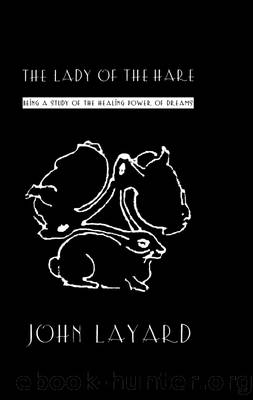Lady Of The Hare by Layard

Author:Layard [Layard]
Language: eng
Format: epub
Tags: Social Science, Anthropology, General, Ethnic Studies, Regional Studies
ISBN: 9781136183102
Google: z-YrBgAAQBAJ
Publisher: Routledge
Published: 2012-10-12T02:37:39+00:00
Connection of the Hare-Deity with Osiris the Moon-god
Le Page Renoufâs article from which these quotations are made, though delivered in the form of a lecture in April 1886, was not published till 1893, but an earlier summary had appeared in Academy in May 1886 (p. 314) and parts of this summary were quoted by Andrew Lang in an article entitled âLe Lièvre dans la Mythologieâ appearing in the French journal Mlusine of 1886-722 already referred to, in which he further discussed the evidence, though without apparently having Le Page Renoufâs full text to refer to, with the result that he expressed himself unable to pronounce on the rival claims for the meaning of un, not seeing that there was in fact no contradiction between the two. Ten years later, in Mélusine, 1896-7 (vol. viii, cols. 25-9), Lefébure, having received a copy of the first edition of Langâs Myth, Ritual, and Religion, in an Appendix of which his previous article was reproduced under the title âThe Hare in Egyptâ,23 took up the cudgels in favour of Le Page Renoufâs interpretation, bringing a great deal of further evidence in support, particularly as regards the actuality of a Hare-deity in Egypt and its connection with Osiris in his aspect as Moon-god as being much more ancient than his equation with the Sun.24
Lefébure first points out that the apparent contradiction between the view expressed by certain savants following Plutarch and late Egyptian records that the title Unnefer given to Osiris means the âGood Beingâ and Le Page Renoufâs interpretation as meaning the âGlorious Hareâ is no contradiction at all if we regard the idea of the Hare as being the more primitive, and that of the âGood Beingâ as being later, since, as Le Page Renouf intimates, this latter meaning is too metaphysical to be original.
He then proceeds, âThere were in Egypt two main figures capable of bearing the head or title ofâ âhareââ¦.
âOne of these figures is the goddess Un-t or Unnu-t belonging to the city of that name, capital city of the fifteenth nome of Upper Egypt, which is also called Un or Unnu, that is to say, according to several Egyptologists, the Nome of the Hare. The inhabitants of this nome adored a feminine deity called sometimes Un-t, sometimes Nehemauai, âshe who averts evilâ, and sometimes Sefekh, âShe who inverts the horns (the moon?)â; at Dendera the goddess Hathor was identified with this triple local form, here called also Shepes, ânobleâ. As, from Pyramid times onward, this same city Unnu of the South had its parallel in the Northern Unnu of Lower Egypt, this goddess became doubled into an Un-t of the South and an Un-t of the North, which appear together on a monument of the Saite period. Of these the most important was she of the South, who existed in the IVth Dynasty as shown in a fire-lighting formula found in the temple of Unnu-t, the mistress of Unnu.25 This goddess was, in the Ptolemaic period, represented as having
Download
This site does not store any files on its server. We only index and link to content provided by other sites. Please contact the content providers to delete copyright contents if any and email us, we'll remove relevant links or contents immediately.
Man and His Symbols by Carl Gustav Jung(3322)
[2004] Mass Psychology (Penguin Modern Classics) by Sigmund Freud(1168)
Angel Dreams by Virtue Doreen Virtue Melissa(1145)
God's Prophetic Symbolism in Everyday Life by Adam Thompson & Adrian Beale(1133)
Forgotten Language by Erich Fromm(1006)
Dreams by C. G. Jung(1002)
Inner Work by Johnson Robert A(974)
Mass Psychology (Penguin Modern Classics) by Sigmund Freud(968)
Conscious Dreaming: A Spiritual Path for Everyday Life by Robert Moss(965)
12,000 Dreams Interpreted by Linda Shields(961)
Inner Work Using Dreams & Active Imagination For Personal Growth - Robert A. Johnson by Robert A. Johnson(936)
Be Wise Now by Gael McCool(928)
The Art Of Dreaming by Carlos Castaneda(909)
The Pizza Party by Theo Baker(906)
Chicken Soup for the Soul by Amy Newmark & Kelly Sullivan Walden(905)
The Pagan Dream of the Renaissance by Joscelyn Godwin(875)
American Dreams by Unknown(860)
Leopard Warrior by John Lockley(844)
Conscious Dreaming by Robert Moss(833)
